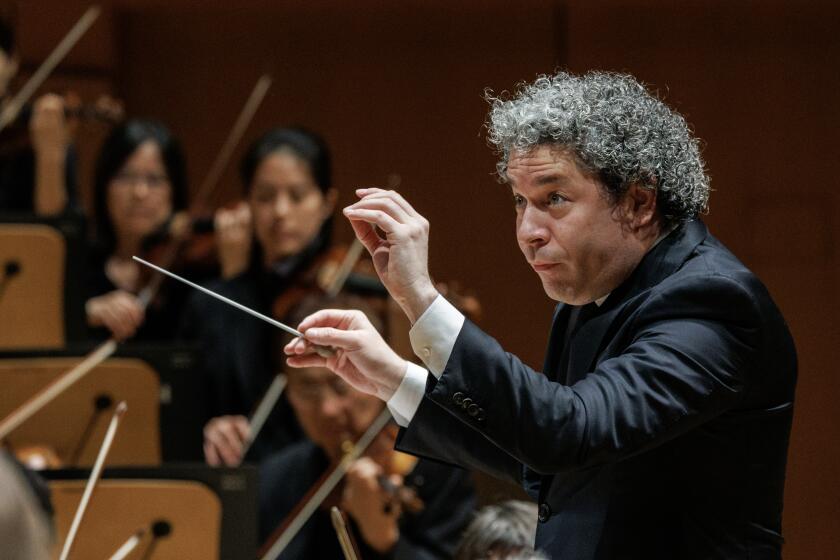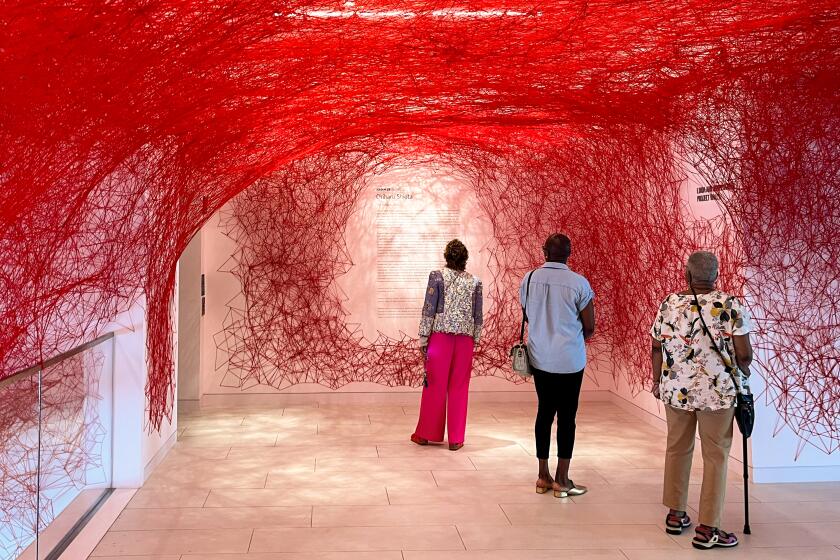MUSIC AND DANCE : VIDEOS : Historic Italian Opera Performances
Complete opera videos are flooding the market at such a rate that enthusiasts soon will have to contemplate moving to a larger apartment or adding a room to the house for storage space. A spate of recent releases dating from 1961 through 1992 are of more than passing interest, beginning with a series from the former year during a Japanese tour of a makeshift Italian company.
In black-and-white and with mostly crude camera work and tacky sets, the performances are historic for capturing the work of some of the greatest Italian singers of more than a generation ago. Puccini’s “Tosca” (VAI 69085) is notable for a vocally resplendent Renata Tebaldi in the title role and a brutally menacing Scarpia of Gian Giacomo Guelfi. The soprano, looking rather dowdy in dress and wig, is joined by the trumpet-voiced Mario del Monaco in one of their specialties, “Andrea Chenier” (VAI 69083). One doesn’t often hear vocalism of such lyric pulse and dramatic abandon, especially today.
Mascagni’s “Cavalleria Rusticana” (VAI 69084) has the great Santuzza of Guilietta Simionato, sung with an aristocratic discipline and musicality. In the crowd scenes, Rome, Paris and a Sicilian village seem to be inhabited entirely by Japanese tourists.
Fast-forwarding to 1982, there is a splendid Salzburg performance in color, as all here, of Verdi’s “Falstaff” (Sony S2HV 48422) directed and conducted by Herbert von Karajan. This was taped before the maestro fell into his last overrefined period and is as buoyant and lilting a reading as could be wished for.
The cast is polyglot international, headed by the then-66-year-old Giuseppe Taddei as Sir John, a characterization richly sung and acted with color and verve. His most notable colleagues include Francisco Araiza as a fresh-voiced Fenton, Janet Perry, with ethereal pianissimi as an uncommonly pretty Nannetta, Christa Ludwig as a sly Quickly and Heinz Zednik, a befuddled Bardolfo.
The camera work is imaginatively handled for a production designed by Gunther Schneider-Siemssen that is traditionally conservative; someone should have told Karajan that in Protestant Elizabethan England windows did not slide open from the bottom up, and a Merry Wife who crossed herself could end up in jail, or worse.
*
The chief interest in a 1988 “Barbiere di Siviglia” (BMG 09026-61217-3) from Cologne is the very young (22) Cecilia Bartoli, in her first complete opera telecast. She was not at that time the vocal mistress that she became a few years later, but she is clearly a stage animal, and if her eyes are ever reported to Rev. Wildmon, she’d be in trouble.
The conducting of Gabriele Ferro is idiomatic, and Gino Quilico, as a mellifluous barber, and Carlos Feller, as a thankfully schtick-free Bartolo, give distinguished performances under Michael Hampe’s rather heavy-handed direction.
A 1990 Rome “Tosca” (BMG 09026-61806-3) is one of the best musically and dramatically integrated of these releases. Conducted with passion and control by Daniel Oren (in a black yarmulke with gold embroidery) in stark, stylized, abstract sets that really work (by Mario Ceroll, Enzo Cucchi and Gianfranco Fini), a honey-voiced Luciano Pavarotti excels (“E lucevan” is repeated). Raina Kabaivanska may be a bit long in the tooth vocally but she looks and acts well, making up for some timbral unevenness and occasional strain. Her Tosca is the real thing.
Claudio Abbado proves he is as adept a Mozartean as he is a Verdian in a 1991 “Nozze di Figaro” (Sony SHV 46406) from Vienna. He reminds one of the unspoiled Karajan of the ‘50s with his lovingly disciplined command of the ensemble. Cheryl Studer’s limpid, achingly sad Countess stands out, as does Ruggero Raimondi’s bel-canto horniness as the Count. Lucio Gallo is an unusually boyish Figaro, seeming much younger than the somewhat coarse (both vocally and physically) Susanna of Marie McLaughlin. Jonathan Miller’s staging is inventive without descending to vulgarity or camp.
Caveat emptor: Run, don’t walk from the 1992 Riccardo Muti/Scala “Traviata” (Sony S2HV 48353). Singing half the time off pitch, Tiziana Fabbricini gives her now-famous Callas impersonation as Violetta in a production directed by Liliana Cavani where there is a pool table in Violetta’s bedroom and she receives a perfect stranger in her nightgown. Muti’s orchestral brilliance can’t make up for this nonsense.
More to Read
The biggest entertainment stories
Get our big stories about Hollywood, film, television, music, arts, culture and more right in your inbox as soon as they publish.
You may occasionally receive promotional content from the Los Angeles Times.






